Solar eclipse of October 4, 2089
A total solar eclipse will occur on October 4, 2089. A solar eclipse occurs when the Moon passes between Earth and the Sun, thereby totally or partly obscuring the image of the Sun for a viewer on Earth. A total solar eclipse occurs when the Moon's apparent diameter is larger than the Sun's, blocking all direct sunlight, turning day into darkness. Totality occurs in a narrow path across Earth's surface, with the partial solar eclipse visible over a surrounding region thousands of kilometres wide. The tables below contain detailed predictions and additional information on the Total Solar Eclipse of 4 October 2089.
| Solar eclipse of October 4, 2089 | |
|---|---|
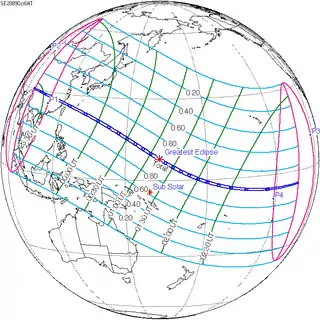 Map | |
| Type of eclipse | |
| Nature | Total |
| Gamma | 0.2167 |
| Magnitude | 1.0333 |
| Maximum eclipse | |
| Duration | 194 sec (3 m 14 s) |
| Coordinates | 7.4°N 162.8°E |
| Max. width of band | 115 km (71 mi) |
| Times (UTC) | |
| Greatest eclipse | 1:15:23 |
| References | |
| Saros | 145 (26 of 77) |
| Catalog # (SE5000) | 9709 |
Gregorian Calendar: October 4, 2089
Julian Calendar: September 21, 2089
Saros: 145 (26/77)
Node: Ascending
Greatest Eclipse: 2089 October 04 at 01:13:26.4 UTC
Eclipse Magnitude: 1.03333
Eclipse Obscuration: 1.06777
Gamma: 0.21671
Ecliptic Conjunction: 2089 October 04 at 01:15:43.6 UTC
Equatorial Conjunction: 2089 October 04 at 01:06:16.2 UTC
Sun Right Ascension: 12h42m34.2s
Sun Declination: -04º34'29.0"
Sun Diameter: 1918.2 arcseconds
Sun Equatorial Horizontal Parallax: 0º00'08.8"
Moon Right Ascension: 12h42m49.6s
Moon Declination: -04º22'10.5"
Moon Diameter: 1950.0 arcseconds
Moon Equatorial Horizontal Parallax: 0º59'38.5"
Delta T: 1 minute, 56.8 seconds
Related eclipses
Solar eclipses 2087–2090
This eclipse is a member of a semester series. An eclipse in a semester series of solar eclipses repeats approximately every 177 days and 4 hours (a semester) at alternating nodes of the Moon's orbit.[1]
| 120 | May 2, 2087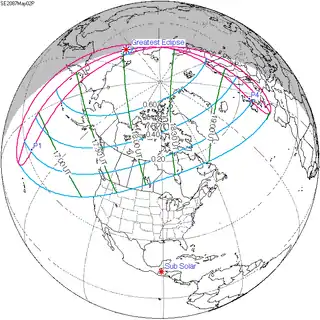 Partial |
125 | October 26, 2087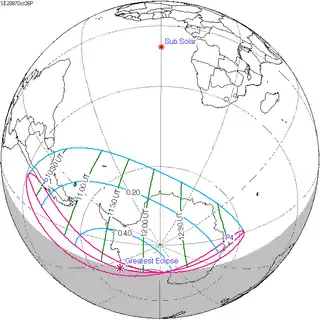 Partial |
| 130 | April 21, 2088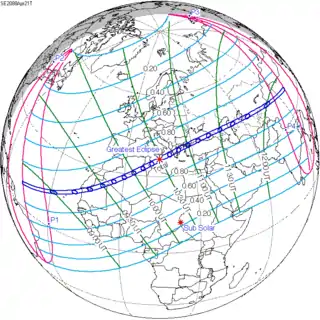 Total |
135 | October 14, 2088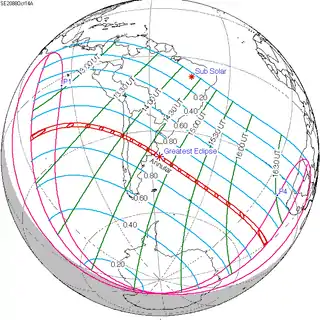 Annular |
| 140 | April 10, 2089 Annular |
145 | October 4, 2089 Total |
| 150 | March 31, 2090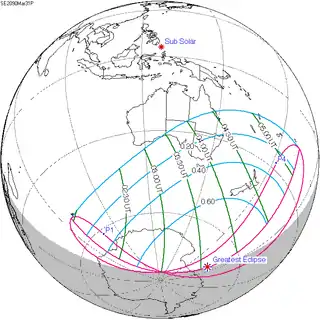 Partial |
155 | September 23, 2090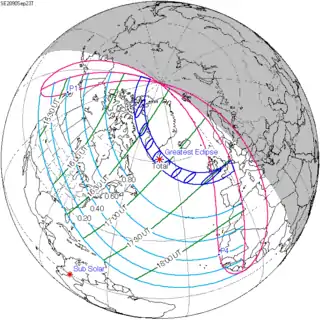 Total |
Saros series 145
This solar eclipse is a part of Saros cycle 145, repeating every 18 years, 11 days, 8 hours, containing 77 events. The series started with a partial solar eclipse on January 4, 1639, and reached a first annular eclipse on June 6, 1891. It was a hybrid event on June 17, 1909, and total eclipses from June 29, 1927, through September 9, 2648. The series ends at member 77 as a partial eclipse on April 17, 3009. The longest eclipse will occur on June 25, 2522, with a maximum duration of totality of 7 minutes, 12 seconds. All eclipses in this series occurs at the Moon's ascending node.
| Series members 10–32 occur between 1801 and 2359 | ||
|---|---|---|
| 10 | 11 | 12 |
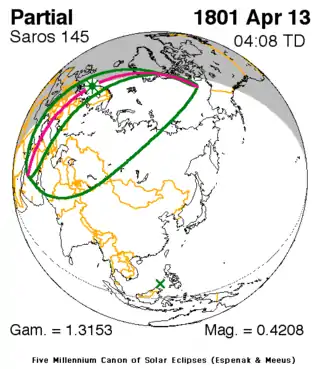 April 13, 1801 |
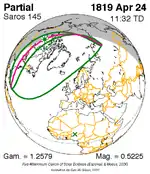 April 24, 1819 |
 May 4, 1837 |
| 13 | 14 | 15 |
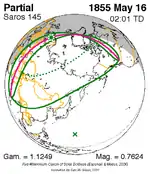 May 16, 1855 |
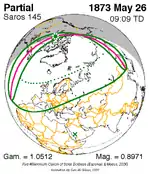 May 26, 1873 |
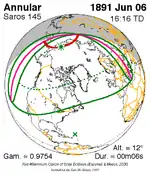 June 6, 1891 |
| 16 | 17 | 18 |
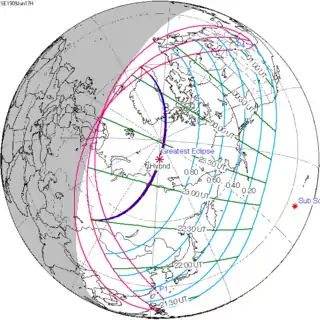 June 17, 1909 |
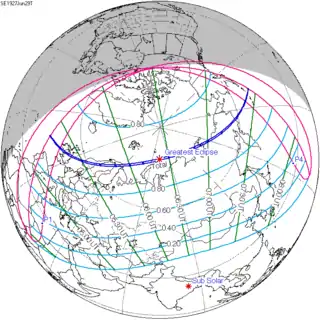 June 29, 1927 |
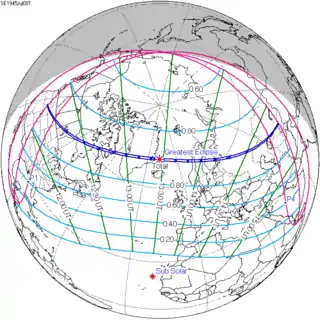 July 9, 1945 |
| 19 | 20 | 21 |
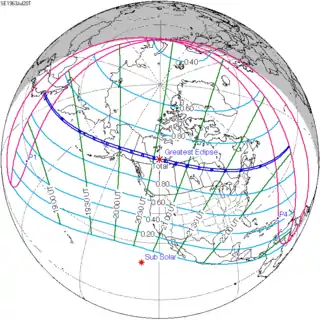 July 20, 1963 |
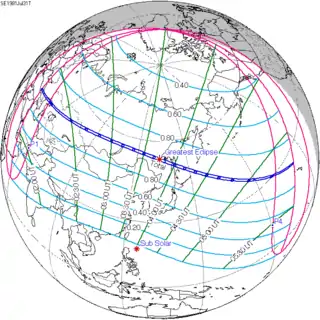 July 31, 1981 |
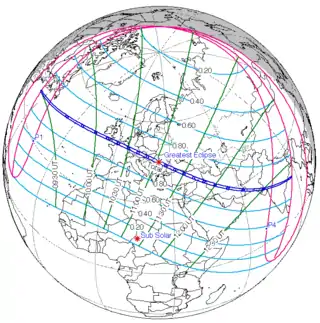 August 11, 1999 |
| 22 | 23 | 24 |
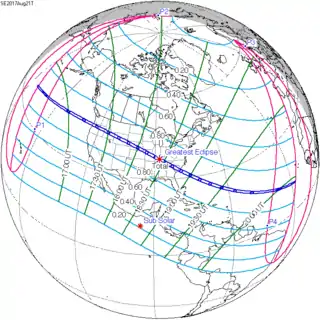 August 21, 2017 |
 September 2, 2035 |
 September 12, 2053 |
| 25 | 26 | 27 |
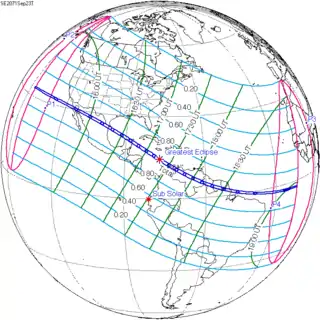 September 23, 2071 |
 October 4, 2089 |
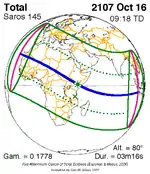 October 16, 2107 |
| 28 | 29 | 30 |
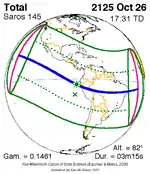 October 26, 2125 |
 November 7, 2143 |
 November 17, 2161 |
| 31 | 32 | 33 |
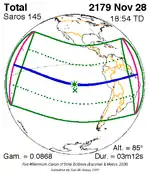 November 28, 2179 |
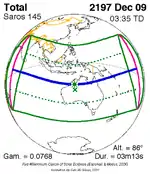 December 9, 2197 |
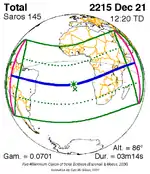 December 21, 2215 |
| 34 | 35 | 36 |
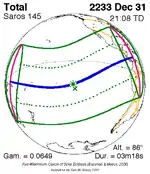 December 31, 2233 |
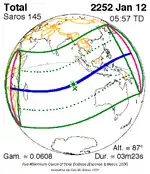 January 12, 2252 |
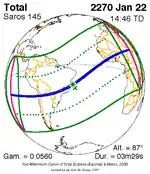 January 22, 2270 |
| 37 | 38 | 39 |
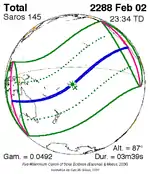 February 2, 2288 |
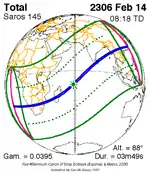 February 14, 2306 |
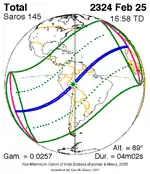 February 25, 2324 |
| 40 | ||
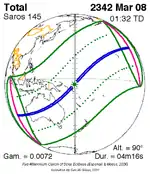 March 8, 2342 | ||
Tritos series
This eclipse is a part of a tritos cycle, repeating at alternating nodes every 135 synodic months (≈ 3986.63 days, or 11 years minus 1 month). Their appearance and longitude are irregular due to a lack of synchronization with the anomalistic month (period of perigee), but groupings of 3 tritos cycles (≈ 33 years minus 3 months) come close (≈ 434.044 anomalistic months), so eclipses are similar in these groupings.
| Series members between 1801 and 2100 | |||
|---|---|---|---|
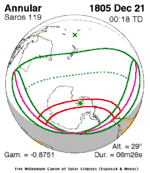 December 21, 1805 (Saros 119) |
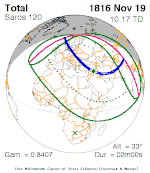 November 19, 1816 (Saros 120) |
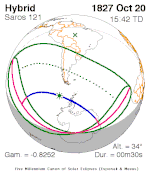 October 20, 1827 (Saros 121) | |
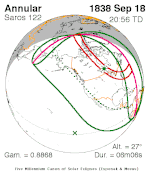 September 18, 1838 (Saros 122) |
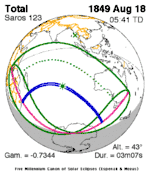 August 18, 1849 (Saros 123) |
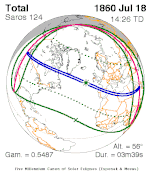 July 18, 1860 (Saros 124) | |
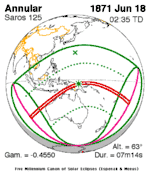 June 18, 1871 (Saros 125) |
 May 17, 1882 (Saros 126) |
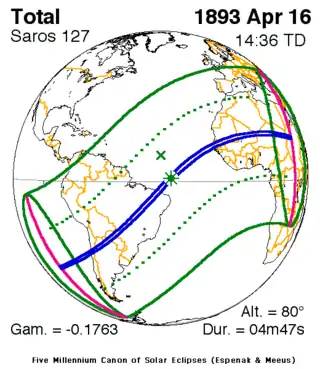 April 16, 1893 (Saros 127) | |
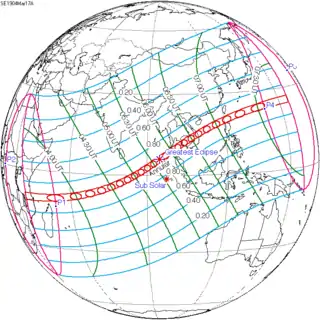 March 17, 1904 (Saros 128) |
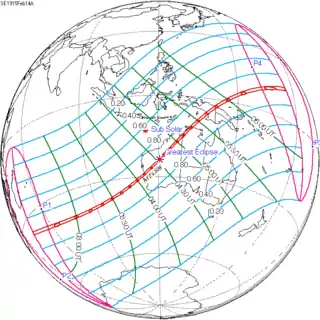 February 14, 1915 (Saros 129) |
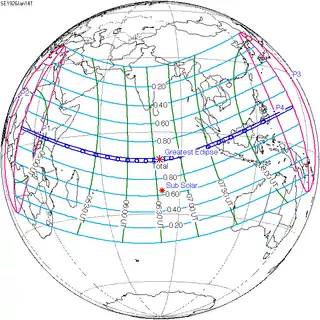 January 14, 1926 (Saros 130) | |
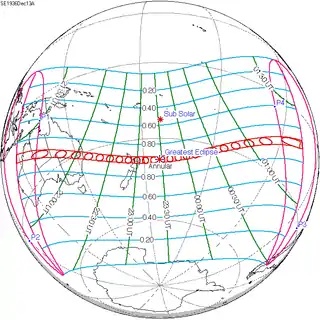 December 13, 1936 (Saros 131) |
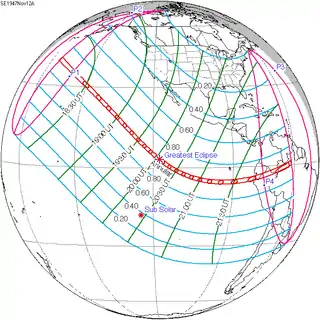 November 12, 1947 (Saros 132) |
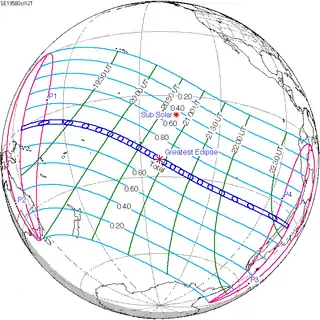 October 12, 1958 (Saros 133) | |
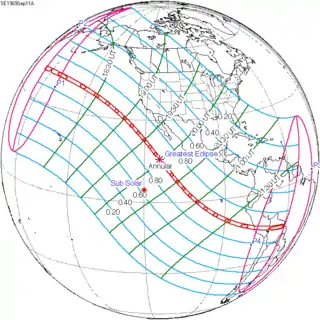 September 11, 1969 (Saros 134) |
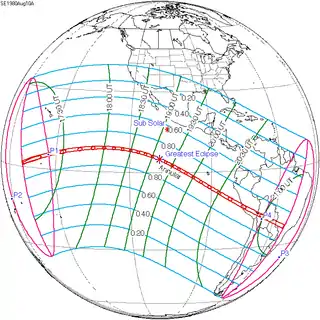 August 10, 1980 (Saros 135) |
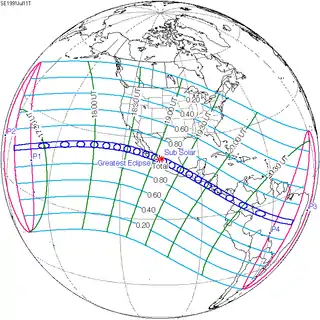 July 11, 1991 (Saros 136) | |
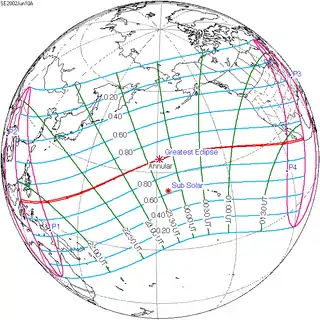 June 10, 2002 (Saros 137) |
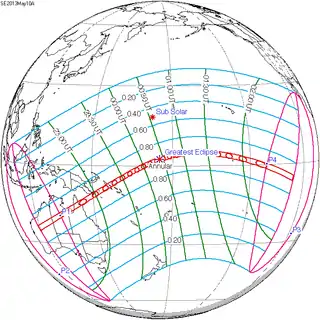 May 10, 2013 (Saros 138) |
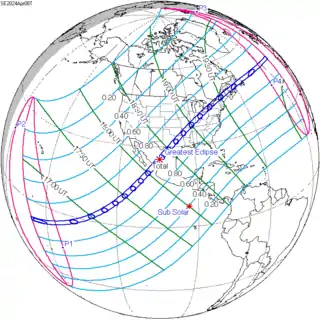 April 8, 2024 (Saros 139) | |
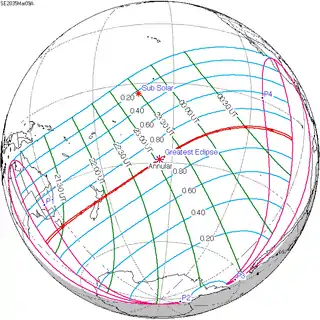 March 9, 2035 (Saros 140) |
 February 5, 2046 (Saros 141) |
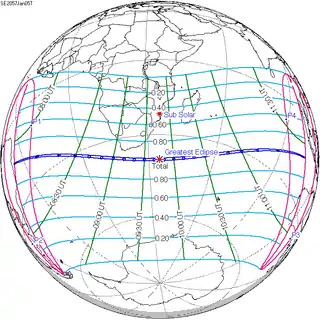 January 5, 2057 (Saros 142) | |
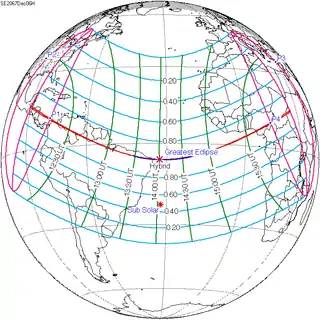 December 6, 2067 (Saros 143) |
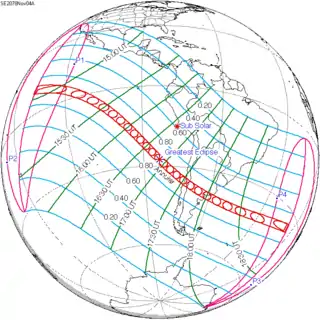 November 4, 2078 (Saros 144) |
 October 4, 2089 (Saros 145) | |
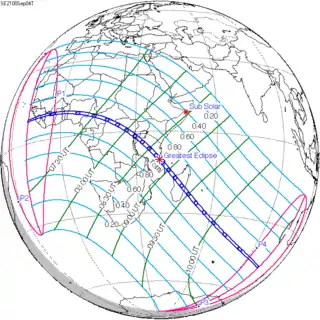 September 4, 2100 (Saros 146) |
|||
In the 22nd century:
- Solar Saros 147: Annular Solar Eclipse of 2111 Aug 04
- Solar Saros 148: Total Solar Eclipse of 2122 Jul 04
- Solar Saros 149: Total Solar Eclipse of 2133 Jun 03
- Solar Saros 150: Annular Solar Eclipse of 2144 May 03
- Solar Saros 151: Annular Solar Eclipse of 2155 Apr 02
- Solar Saros 152: Total Solar Eclipse of 2166 Mar 02
- Solar Saros 153: Annular Solar Eclipse of 2177 Jan 29
- Solar Saros 154: Annular Solar Eclipse of 2187 Dec 29
- Solar Saros 155: Total Solar Eclipse of 2198 Nov 28
In the 23rd century:
- Solar Saros 156: Annular Solar Eclipse of 2209 Oct 29
- Solar Saros 157: Annular Solar Eclipse of 2220 Sep 27
- Solar Saros 158: Total Solar Eclipse of 2231 Aug 28
- Solar Saros 159: Partial Solar Eclipse of 2242 Jul 28
- Solar Saros 160: Partial Solar Eclipse of 2253 Jun 26
- Solar Saros 161: Partial Solar Eclipse of 2264 May 26
- Solar Saros 162: Partial Solar Eclipse of 2275 Apr 26
- Solar Saros 163: Partial Solar Eclipse of 2286 Mar 25
- Solar Saros 164: Partial Solar Eclipse of 2297 Feb 22
Notes
- van Gent, R.H. "Solar- and Lunar-Eclipse Predictions from Antiquity to the Present". A Catalogue of Eclipse Cycles. Utrecht University. Retrieved 6 October 2018.
References
- Earth visibility chart and eclipse statistics Eclipse Predictions by Fred Espenak, NASA/GSFC
.jpg.webp)

